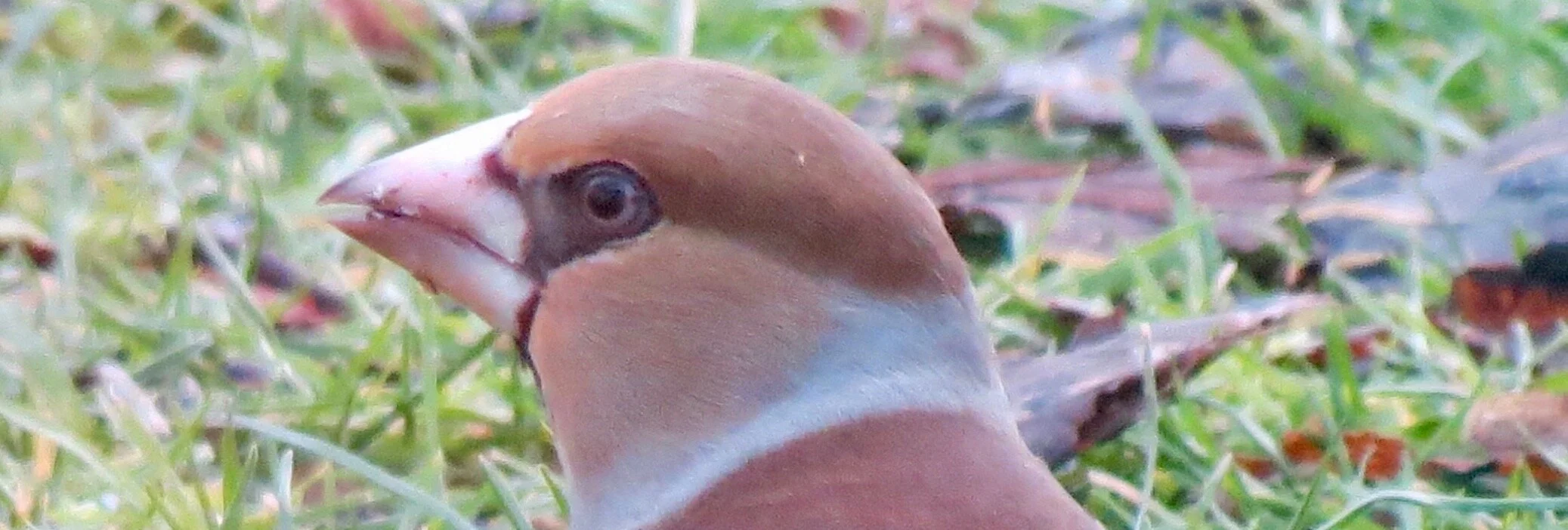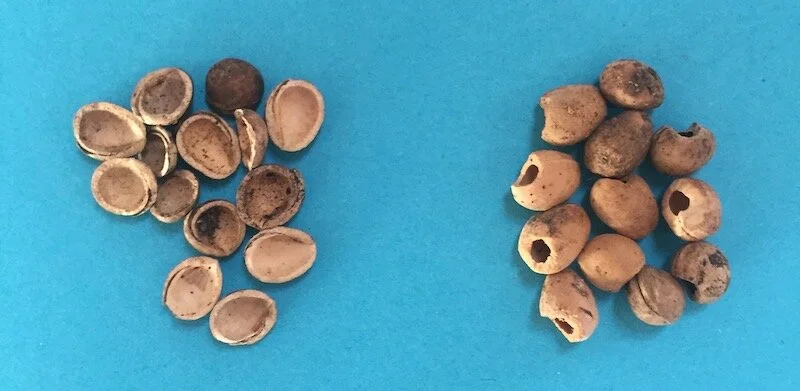It was like an early Christmas present; I had been wanting to see this bird for a long time. But seeing it in the Highlands (extremely unusual) right below my feeding station in Rafford . . . what are the chances of that?
I see a variety of birds on and around the feeder, and the finch list includes Chaffinch, Greenfinch, Goldfinch, Bullfinch, Brambling and Siskin. But on Christmas Eve I did a double-take. There, right below the feeder was no regular, nor even slightly unusual, finch.
Buffs, greys and rust browns with a white tail tip. Bulky head and neck with smart Goth eyeliner stretching down to a neat black beard. The grey wing patch of the female and legs and bill tinged with rose. It was the bill itself that really caught my eye. Those chunky, wedge shaped, cherry-stone-cracking mandibles were making short work of the black sunflower seeds below the tube feeder. I knew what I was seeing even though my brain was struggling to register it. Hawfinch!
Hawfinch with Goth eyeliner. And did I tell you about the 50kg of crushing force?
I couldn't believe my luck. I took some photos and watched for a few minutes longer. She was very flighty and got spooked by a Woodpigeon walking in her direction. I reported the sighting to Martin Cook at Moray Bird Club and he told me it was only the fifteenth record in Moray and Nairn, and just the third midwinter record.
Hawfinches are striking birds. As the name suggests Hawthorn stone kernels form part of the diet. They are also known for being partial to the kernels of cherry stones. The scientific name Coccothraustes coccothraustes comes from Greek and means ‘seed-breaker’ (or I suppose ‘seed-breaker seed-breaker’, leaving us in no doubt about the fact that it breaks seeds). I read that the bill can exert over 50 kg of crushing force. I’ve lost count of how many times I quoted that fact to anyone who will listen. I just find it impressively cool.
Gimme something to crack . . .
A friend told me that he once rescued a Hawfinch from a cat and got a hefty bite (from the bird not the cat) that bled generously. Ornithologists who are ringing birds treat these finches with great respect if they find them in their nets.
The handful of previous records in the area had only been brief visits. I had no idea that she would become a fairly regular visitor, sometimes turning up several days in a row. She very graciously turned up for part of my Big Garden Birdwatch hour. I started paying closer attention to the time she arrived which tended to be at similar times, usually in the morning.
Whenever she was there the other finches and the House and Tree Sparrows - which usually bustle and feed shoulder to shoulder among themselves - almost always gave her a wide berth. I wondered if they were a bit intimidated (perhaps suspecting her of using bill steroids).
Part of the naturalist’s craft is to engage our curiosity and to ask questions. One of my big ones was: what was keeping her in the area? It couldn't just be my feeder. Ornithologist Roy Dennis later told me that they do eat cherry stones from the ground in winter. I hadn't thought of that, just assuming they would focus on extracting them from the fruits themselves. But it made sense. There are quite a few Geans or Wild Cherries (and a lot of cultivated ones) nearby and we've had some really good crops in the last couple of years.
Not long afterwards I was walking below a Gean not far from the house and another ‘first’ caught my eye. Cherry stones freshly split clean in half. Rodents such as Woodmice and Bank Voles get to the kernels in a different way, gnawing a hole in the side. I eagerly gathered up some of these split stones for my track and sign collection. This was clear evidence that cherry stones were forming at least a part of her diet when she was not at the feeder. My next tracking mission is to see how many other trees in the area I can find split stones beneath, and I want to find out whether she's been eating the Hawthorn kernels too. We have a lot of Hawthorn hedges around here and they often have dried haws still attached.
I saw her briefly today while writing this, over six weeks after the first encounter. I’ve no idea how long she'll stick around for, but wherever she goes next I hope she finds a good stash of stones!
Left: Cherry stones split by a Hawfinch using over 50kg of crushing force (did I already mention that?). Right: Stones gnawed open by a Bank Vole.




